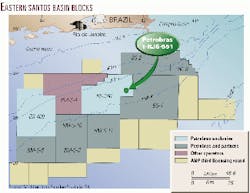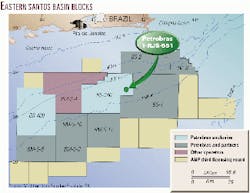E&D action picks up in Santos basin off Brazil
Exploration is slowly picking up in the Santos basin off Brazil.
Petroleo Brasileiro SA (Petrobras) in mid-May announced a deepwater crude oil discovery on the same block where a 1999 discovery failed to hold up to the company's initial reserves assessment.
The 1-RJS-551 discovery well is in 1,498 m of water on Block BS-500.
The discovery is in the eastern Santos basin off Rio de Janeiro state, 170 km south-southeast of Rio de Janeiro. The well, drilled to 4,528 m, penetrated several intervals between 2,524 m and 4,210 m that contained crude oils of varying characteristics.
The interval with favorable characteristics for production has 50 m of porosity distributed between 3,100 m and 3,300 m. A test yielded 22° gravity oil on a 1/4-in. choke. The company used the small choke to avoid sand production. It did not reveal the rate of flow.
The rest of this year Petrobras intends to drill one new wildcat on BS-500 and one or more delineation wells near the 1-RJS-551.
The first oil discovery on Block BS-500 came in 1999 through well 1-RJS-539 in 1,595 m of water. Early reports said the well, which tested 35° gravity oil, established as much as 600-700 million bbl of reserves. Pay was reported at 3,828-34 m and 4,092-4,148 m.
Further seismic work and the drilling of two delineation wells "give signs of an accumulation with a smaller reserve than had been announced at the time," Petrobras now says. Nevertheless, the company plans to intensify its work in the region, to which it will dedicate a rig.
The Santos basin covers 352,000 sq km offshore Santa Catarina, Parana, Sao Paulo, and Rio de Janeiro states.
Exploratory drilling
Meanwhile, a joint venture of four companies headed by Petrobras spudded exploratory well 1-SCS-10 on Block BS-3 (not shown) in the western Santos basin in late April, OGJ Online reported.
The well is in 200 m of water about 100 miles east of the shore base at Itajai. It was to be drilled to 5,200 m TD at cost of $15 million.
Its objectives in the Cretaceous (Albian) Lower Guaruja formation are the same type of reservoirs that have produced in nearby Caravela oil field since 1996. They are also the pay zones at the Coral and Estrelo-do-Mar oil discoveries the group plans to develop under two commercial development licenses (see map, OGJ, Apr. 26, 1999, p. 27).
The companies chose the 1-SCS-10 location based on reinterpretation of existing 3D seismic data and additional conventional seismic lines acquired and processed with the prestack depth migration technique. It is planned as an updip extension to two discoveries made by Petrobras some years ago, officials said.
Petrobras is operator with 35% interest. The partners include Queiroz Galvao Perfuracoes SA 30%, Coplex Petroleo do Brasil Ltda. (Coplex Brasil), the indirect wholly owned subsidiary of Naftex Energy Corp., Vancouver, 27.5%, and Starfish Oil & Gas Co. 7.5%.
Petrobras is carried through the exploration well by the other parties pro rata, officials said.
Previous estimates were for Coral and Estrelo-do-Mar, in 450 m of water, to produce a combined 26.9 million bbl of 37-42° gravity oil. Block BS-3 is in 330-750 m of water.
Exploration history
Between 1971 and the mid 1990s, international companies under risk contracts and Petrobras drilled more than 100 exploration wells in 400 m of water or less in the Santos basin.
These efforts led to Shell/Pecten's 1984 discovery of Merluza gas and condensate field, which has produced about 40% of its reserve of 410 bcfe of gas and gas equivalent (OGJ, July 20, 1992, p. 32).
During the same period, Petrobras discovered four mainly oil accumulations with total reserves of 110 million bbl of oil equivalent (boe) in shallow waters in the western Santos basin.
In 1998, after the enactment of the deregulation law that demonopolized Petrobras, 12 exploratory wells were drilled, five operated by international companies and seven by Petrobras.
Santos blocks
Petrobras is active today in 12 exploratory blocks in Santos basin, working alone on blocks BS-400 and BS-500 and in partnerships with private companies on 10 blocks.
Joint ventures with Petrobras in Santos basin:
Block BS-1: Kerr-McGee 40% (operator), Petrobras 40%, and Esso subsidiary of Exxon 20%.
Block BS-2: Amerada Hess 32% (operator), Petrobras 35%, Agip 25%, and Odebrecht (Brazil), 8%.
Block BS-3: Petrobras 35% (operator), Queiroz Galvao (Brazil) 30%, Coplex (Norway), holding Naftex, 27.5%, and Starfish, 7.5%.
Block BS-4: Shell, 40% (operator), Petrobras 40%, Texaco 20%
Concession granted by the National Petroleum Agency (ANP) in the Santos basin during the first licensing round in September 1999:
Block BMS-3: Amerada Hess 45% (operator), Kerr-McGee, 30%, and Petrobras, 25%.
Concessions granted by ANP in the Santos basin during the second licensing round in September 2000:
Block BMS-7: Chevron, 65% (operator) and Petrobras 35%.
Block BMS-8: Petrobras 50% (operator), Shell 40%, and Petrogal (Portugal) 10%.
Block BMS-9: Petrobras 45% (operator), BG International 30%, and Repsol-YPF 25%.
Block BMS-10: Petrobras 50% (operator), Chevron 25%, and BG International 25%.
Block BMS-11: Petrobras 65% (operator), BG International 25%, and Petrogal (Portugal) 10%.

